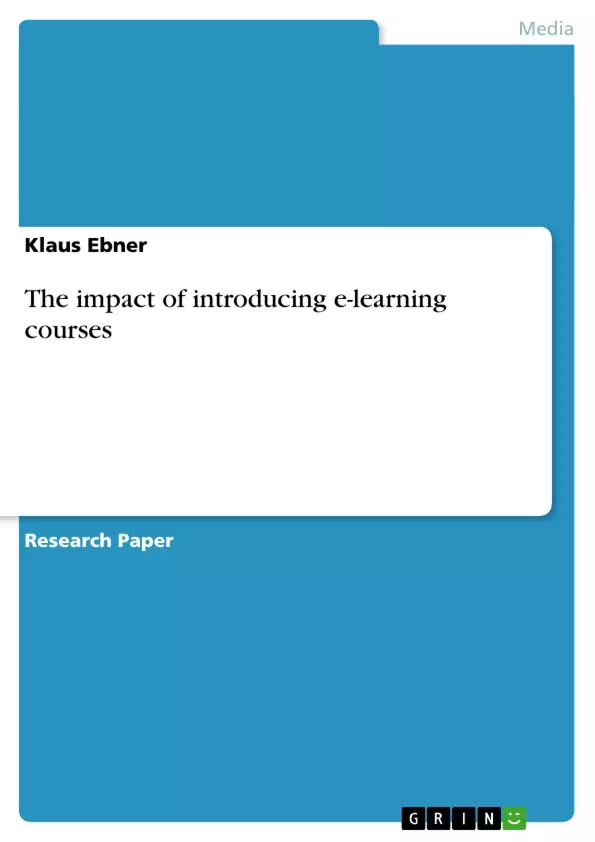This is an English papier about some aspects of introducing e-learning courses in a company. The main example is taken from IBM's education center in Austria and the introduction of Microsoft e-learning courses. The papier is from the year 2001/2002!
Inhaltsverzeichnis (Table of Contents)
- Preface
- 1. Introduction
- 1.1 Some figures.
- 1.2 The advantages of e-learning.
- 1.3 Austria's e-learning market.
- 1.4 The motivation of adopting e-learning.
- 1.5 The cost of education and training.
- 1.6 A few words on the European legal framework.
- 2. What exactly is e-learning?
- 2.1 Distance learning.
- 2.2 Self-study.
- 2.3 Collaborative learning
- 2.4 Teletutoring.
- 2.5 Web-based learning, e-books and Web lectures.
- 2.6 The virtual classroom.
- 2.7 The content
- 2.8 The e-learning matrix.
- 3. Examples that already work
- 3.1 Virtual Universities in Britain and Catalonia.
- 3.2 The Global Campus of South Italian SMBs.
- 3.3 Training future judges in Austria
- 3.4 IBM's 2,500 e-learning programs for employees.
- 4. What about learning theory?
- 4.1 The didactic triangle.
- 4.2 Lesson structure.
- 4.3 Interactive learning
- 4.4 The role of diverse media
- 4.5 Working in groups.
- 4.6 Time scheduling
- 4.7 Instructor requirements.
- 5. The impact on human resource management
- 5.1 Education and training
- 5.2 What HRM can expect from e-learning.
- 6. The e-learning environment puzzle.
- 6.1 The e-learning provider.
- 6.2 The communication channel
- 6.3 The e-learning consumer.
- 6.4 General software requirements
- 6.4.1 The operating system
- 6.4.2 The Learning Management System (LMS)
- 6.4.3 The e-learning content.
- 6.4.4 The user's front-end.
- 6.5 Aspects to consider.
- 6.5.1 Language and localization
- 6.5.2 Measuring the learning progress.
- 7. Austria's project plan
- 7.1 Microsoft MOC e-learning delivery
- 7.1.1 LRN and the Microsoft LRN Toolkit.
- 7.1.2 Microsoft e-learning MOC courses.
- 7.1.3 What Microsoft delivers.
- 7.2 Hardware and software requirements.
- 7.2.1 IIS installation
- 7.2.2 Experiences with a small test environment
- 7.3 Communication.
- 7.3.1 Discussion forums.
- 7.3.2 Chat rooms.
- 7.3.3 Email
- 7.4 The staff.
- 7.5 The role of Central Region
- 7.6 Resumé.
- 7.1 Microsoft MOC e-learning delivery
- 8. Conclusion
- 9. Sources
- 9.1 Literature.
- 9.2 Other sources.
- 9.3 Internet.
Zielsetzung und Themenschwerpunkte (Objectives and Key Themes)
This paper explores the impact of introducing e-learning courses, specifically focusing on the implementation of standard Microsoft e-learning course offerings at IBM Learning Services in Austria. It aims to provide an overview of e-learning theory, its potential benefits for both employees and human resource management, and the practical considerations involved in establishing an e-learning environment. The main themes explored include:- The evolution of e-learning from traditional learning methods
- The advantages and limitations of e-learning
- The practical implementation of e-learning in a real-world setting
- The impact of e-learning on human resource management
- The challenges and considerations involved in implementing e-learning programs.
Zusammenfassung der Kapitel (Chapter Summaries)
The paper begins with an introduction that outlines the increasing popularity of e-learning and its potential benefits. It delves into the advantages of e-learning, examining its flexibility and the lasting impact of e-learning materials. The introduction also explores the e-learning market in Austria and the motivation behind adopting e-learning solutions. Chapter 2 provides a comprehensive definition of e-learning, discussing different instructional models such as distance learning, self-study, collaborative learning, teletutoring, web-based learning, virtual classrooms, and the content and e-learning matrix. Chapter 3 presents successful examples of e-learning implementations from various sectors, including virtual universities, a global campus for South Italian SMBs, and training programs for future judges in Austria. It also highlights IBM's extensive e-learning program for its employees. Chapter 4 delves into learning theory and didactics, examining the didactic triangle, lesson structure, interactive learning, the role of diverse media, working in groups, time scheduling, and instructor requirements. Chapter 5 explores the impact of e-learning on human resource management, examining how e-learning can contribute to employee education and training, and outlining the benefits HRM can expect from e-learning implementation.Schlüsselwörter (Keywords)
This paper focuses on e-learning, particularly the implementation of standard Microsoft e-learning course offerings at IBM Learning Services in Austria. Key topics explored include e-learning theory, instructional models, learning psychology and didactics, human resource management, e-learning environment, communication channels, software requirements, and the challenges and considerations involved in implementing e-learning programs.
Final del extracto de 71 páginas
- subir
- Citar trabajo
- Mag. (FH) Mag. Klaus Ebner (Autor), 2002, The impact of introducing e-learning courses, Múnich, GRIN Verlag, https://www.grin.com/document/22138
Leer eBook



